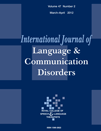Influence of additional language learning on first language learning in children with language disorders
Abstract
Abstract Background: Multilingualism can bring about various positive outcomes to typically developing children. Its effect on children with language difficulties is not yet clear.
Aim: The aim of this study was to examine the effects of multilingual learning as a medium of instruction (MOI) on first language (L1) acquisition of children with language disorders (LD).
Methods & Procedures: Nineteen Cantonese-speaking students aged 5;8–6;8 who were diagnosed with LD were recruited from a school that used Putonghua (an alternative Chinese dialect) as the MOI when learning Chinese language and were compared with 18 age-and-gender-matched Cantonese-speaking students with LD from a school that used Cantonese as the MOI when learning Chinese language. All the students also learned English (L2) as a subject at school. Proficiency in Cantonese was tested at the beginning and the end of the semester in Grade One in terms of: (1) grammar, (2) expressive vocabulary, (3) auditory textual comprehension, (4) word definition and (5) narration.
Outcomes & Results: Mixed-model ANOVAs revealed an effect of time on language proficiency indicating positive gains in both groups. Interaction effects between time and group were not significant. There was a trend that children learning Putonghua showed slightly more improvement in auditory textual comprehension.
Conclusions & Implications: Proficiency gains were similar across groups. The study found no evidence that a multilingual learning environment hinders the language proficiency in L1 in students who have LD.




